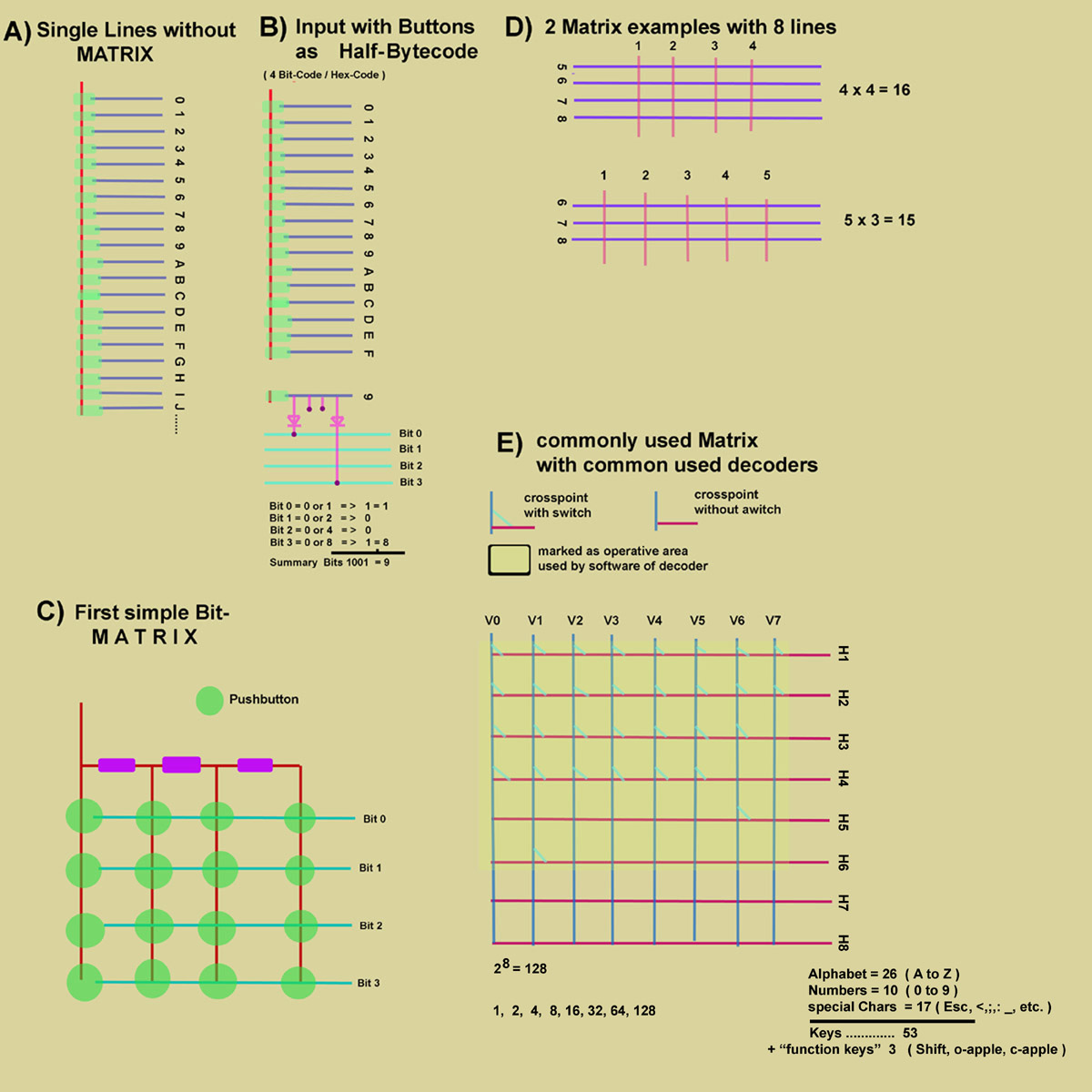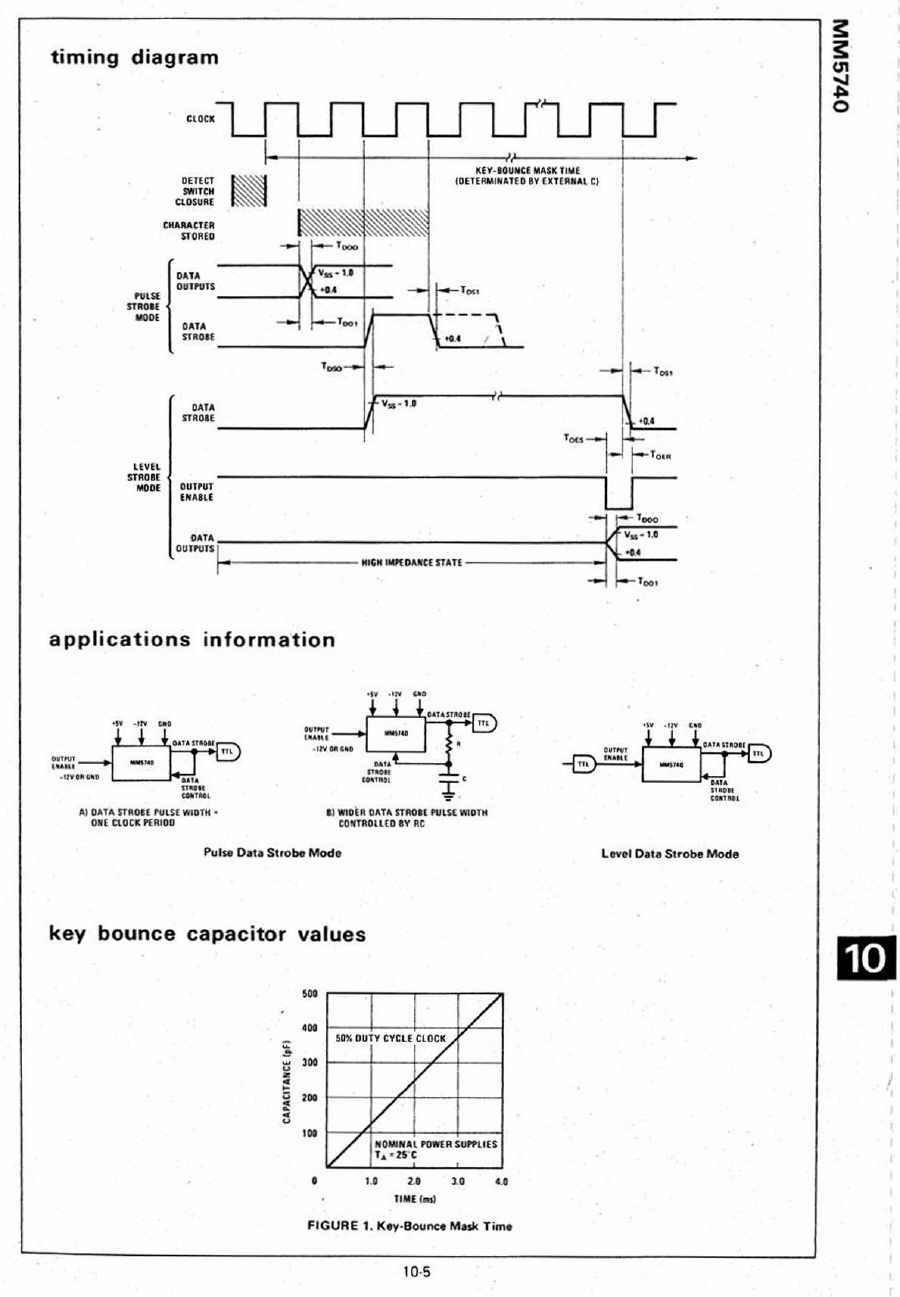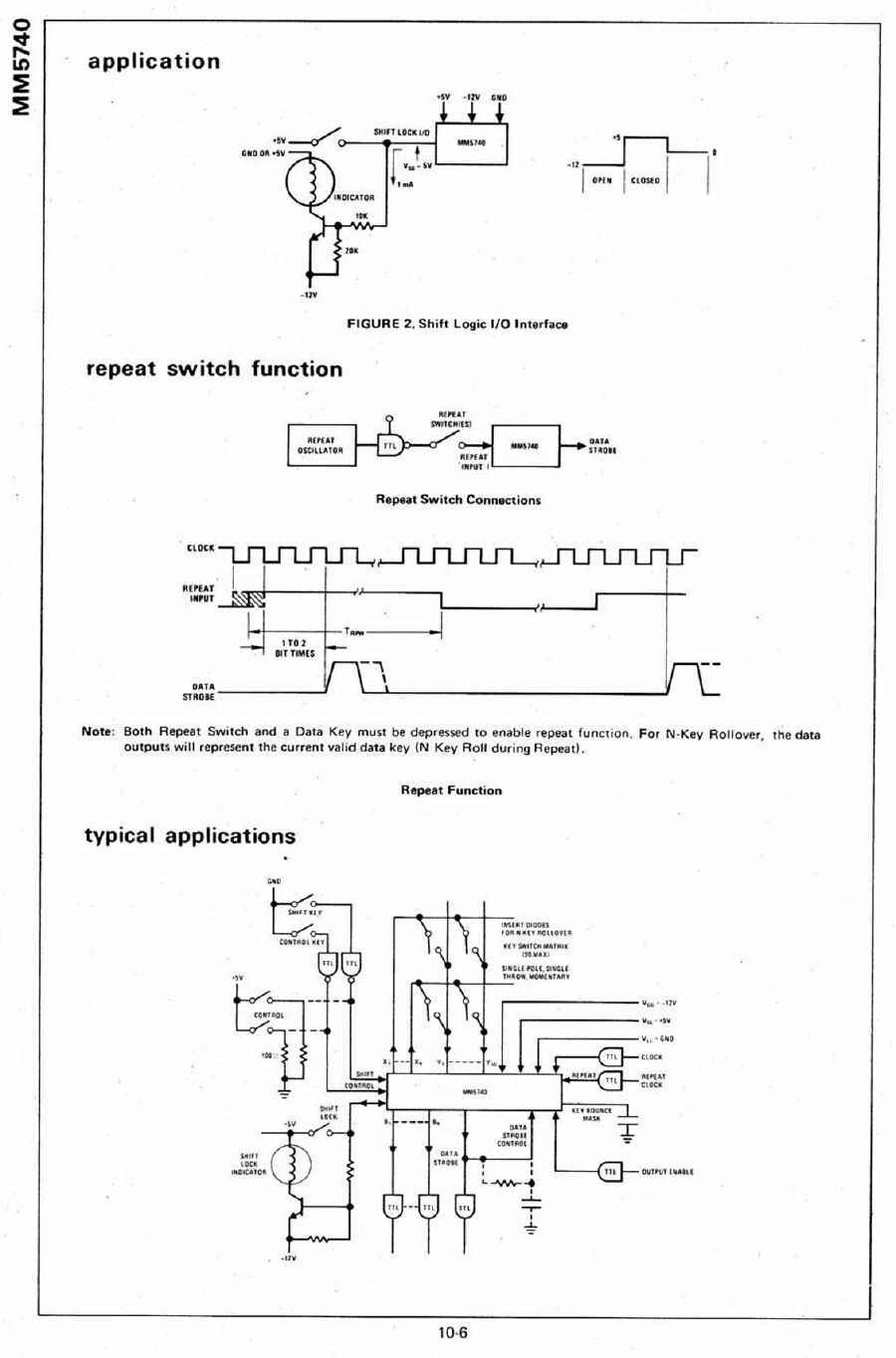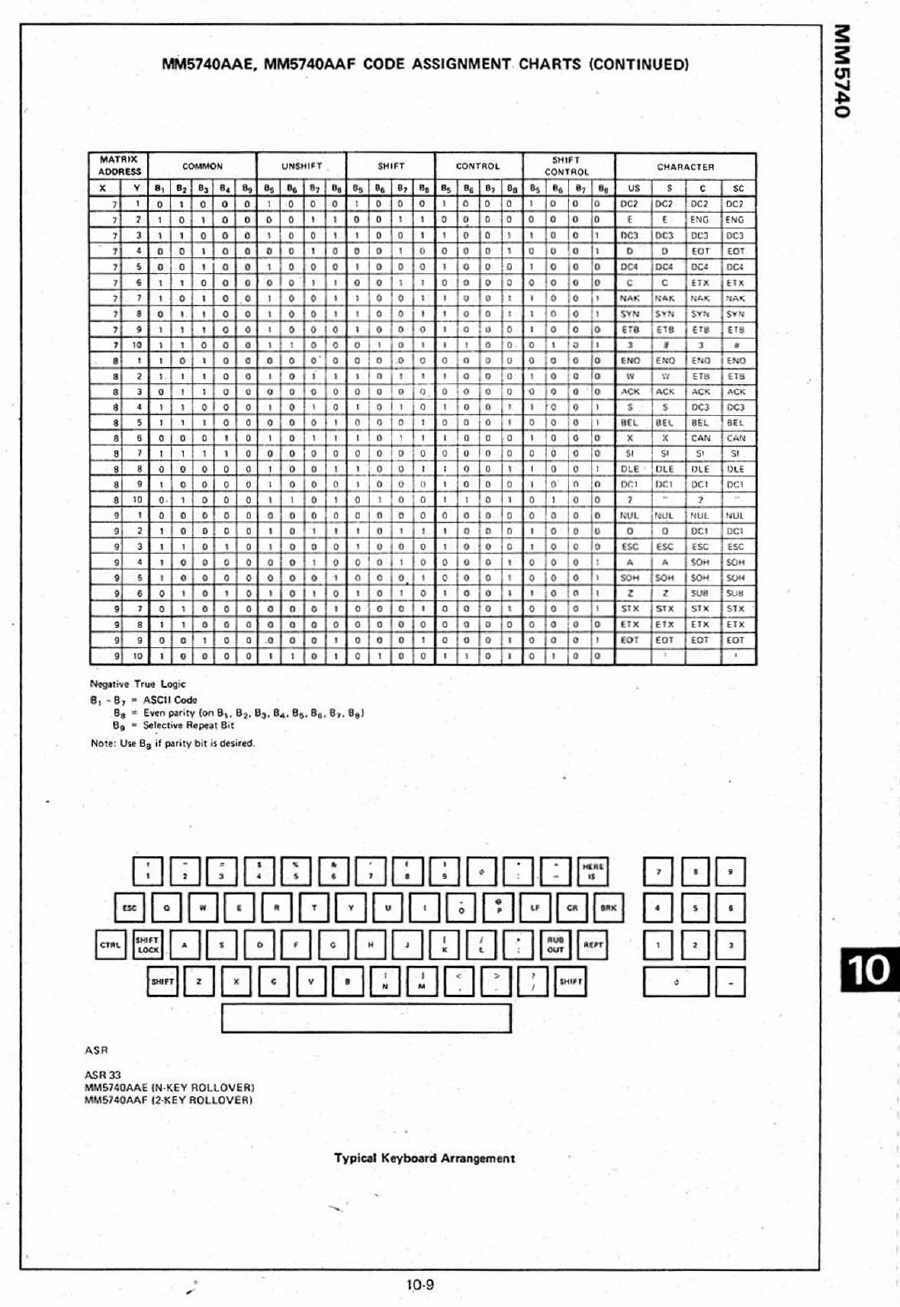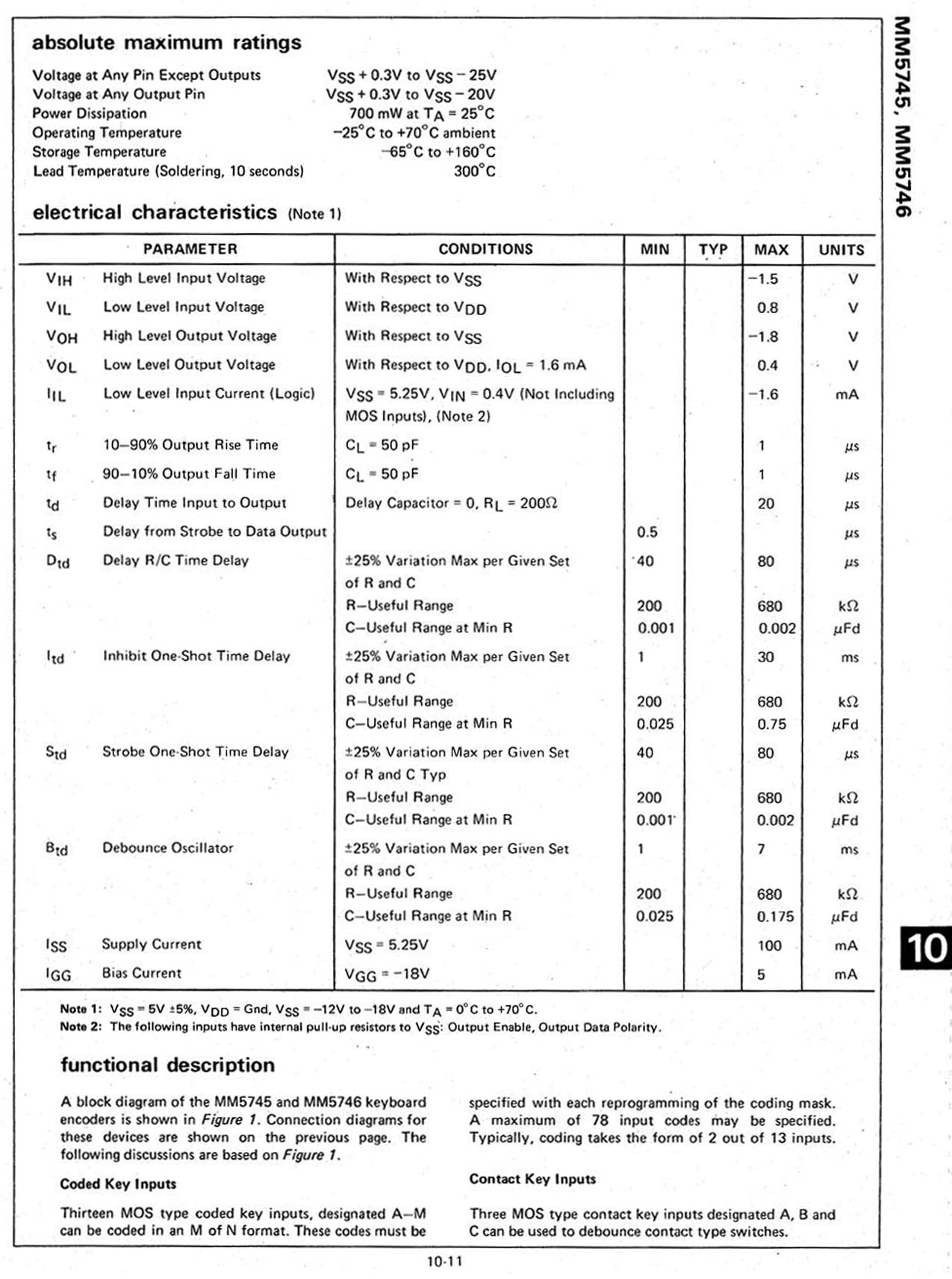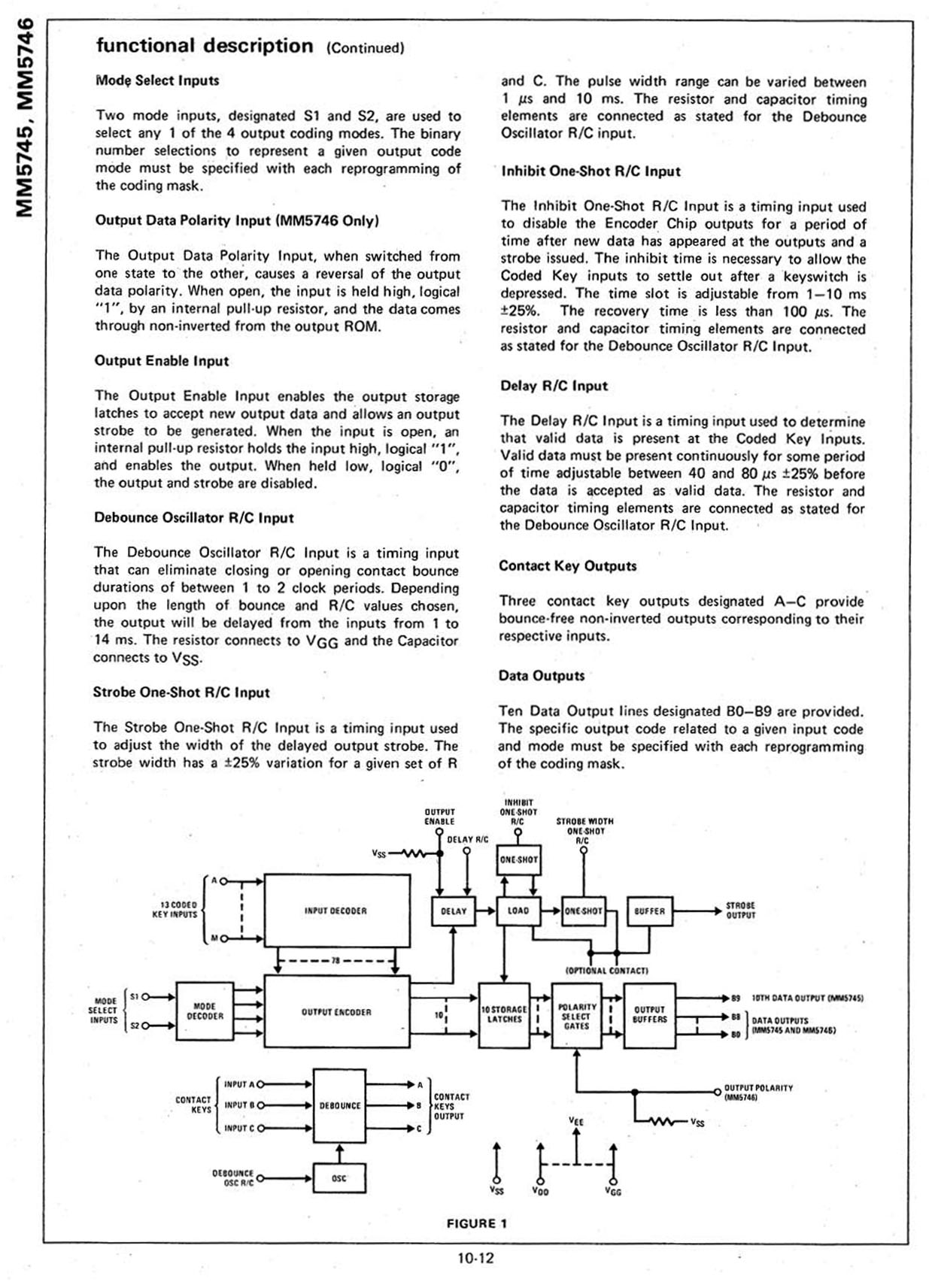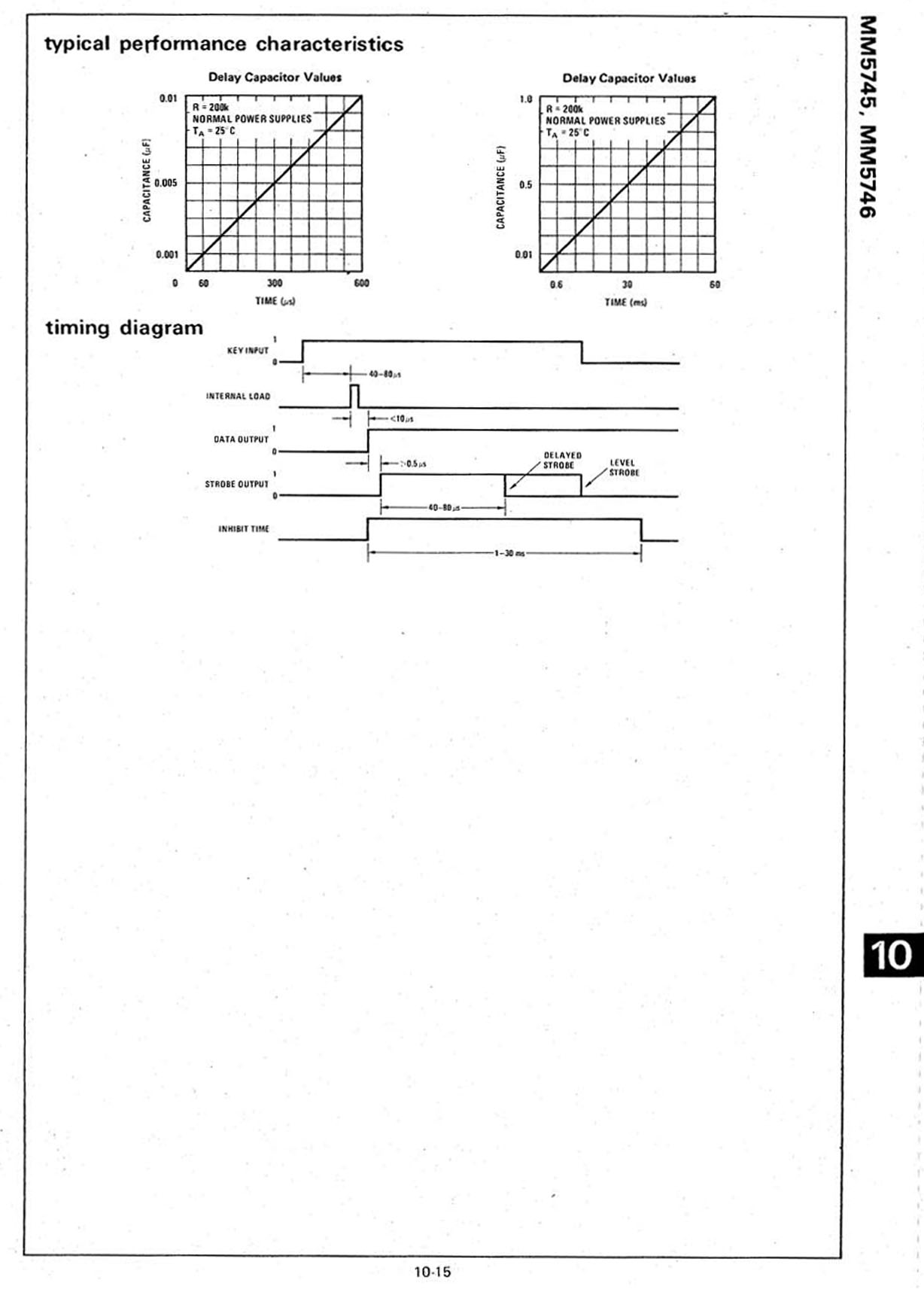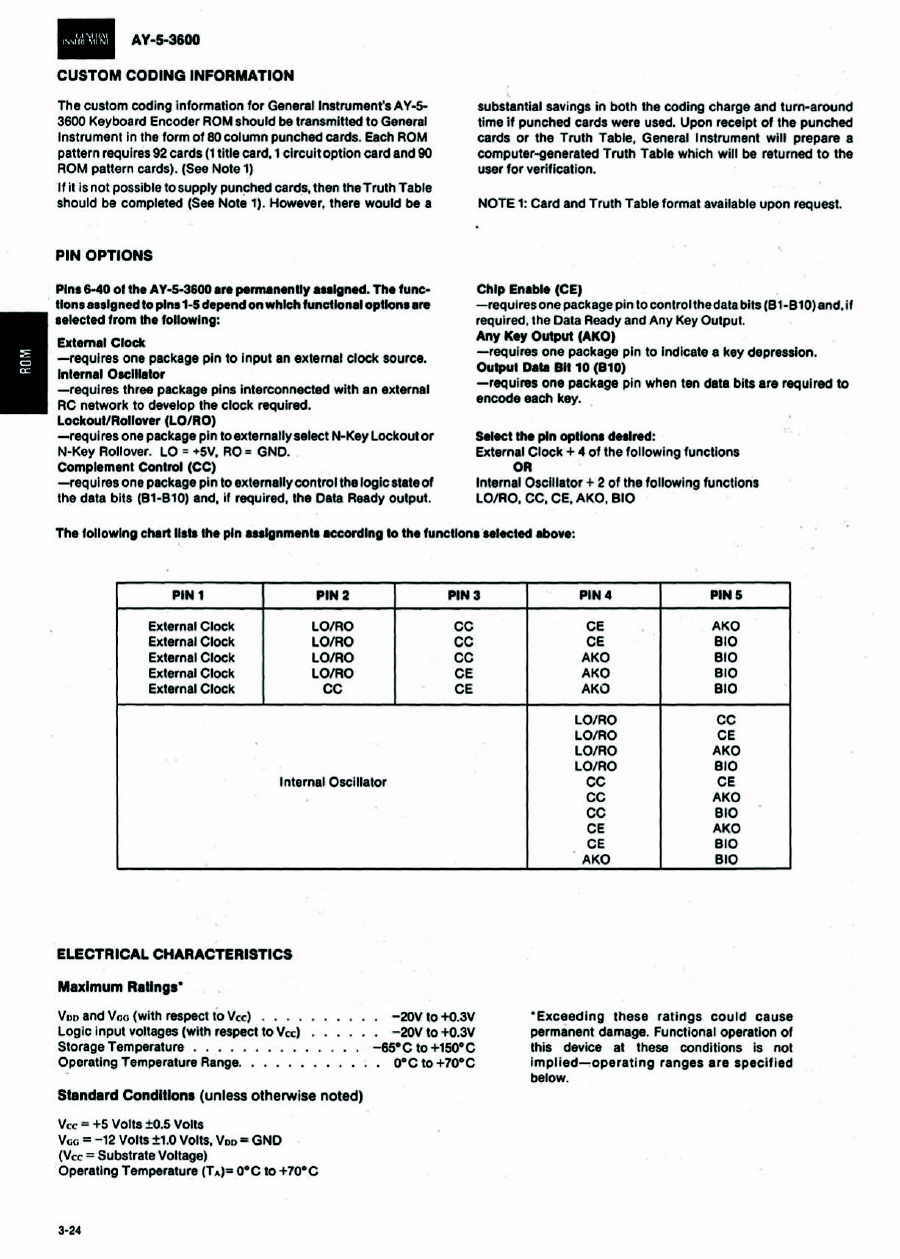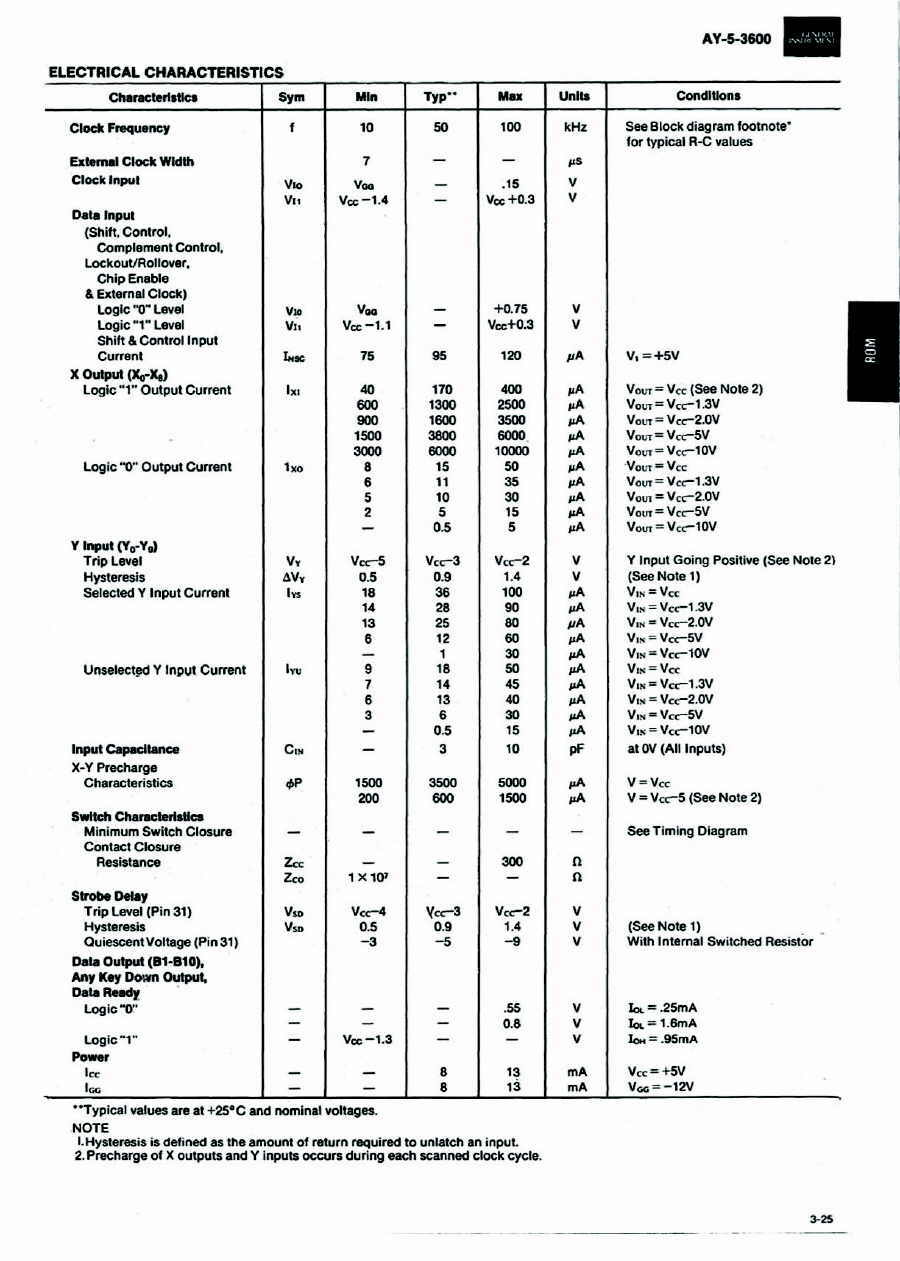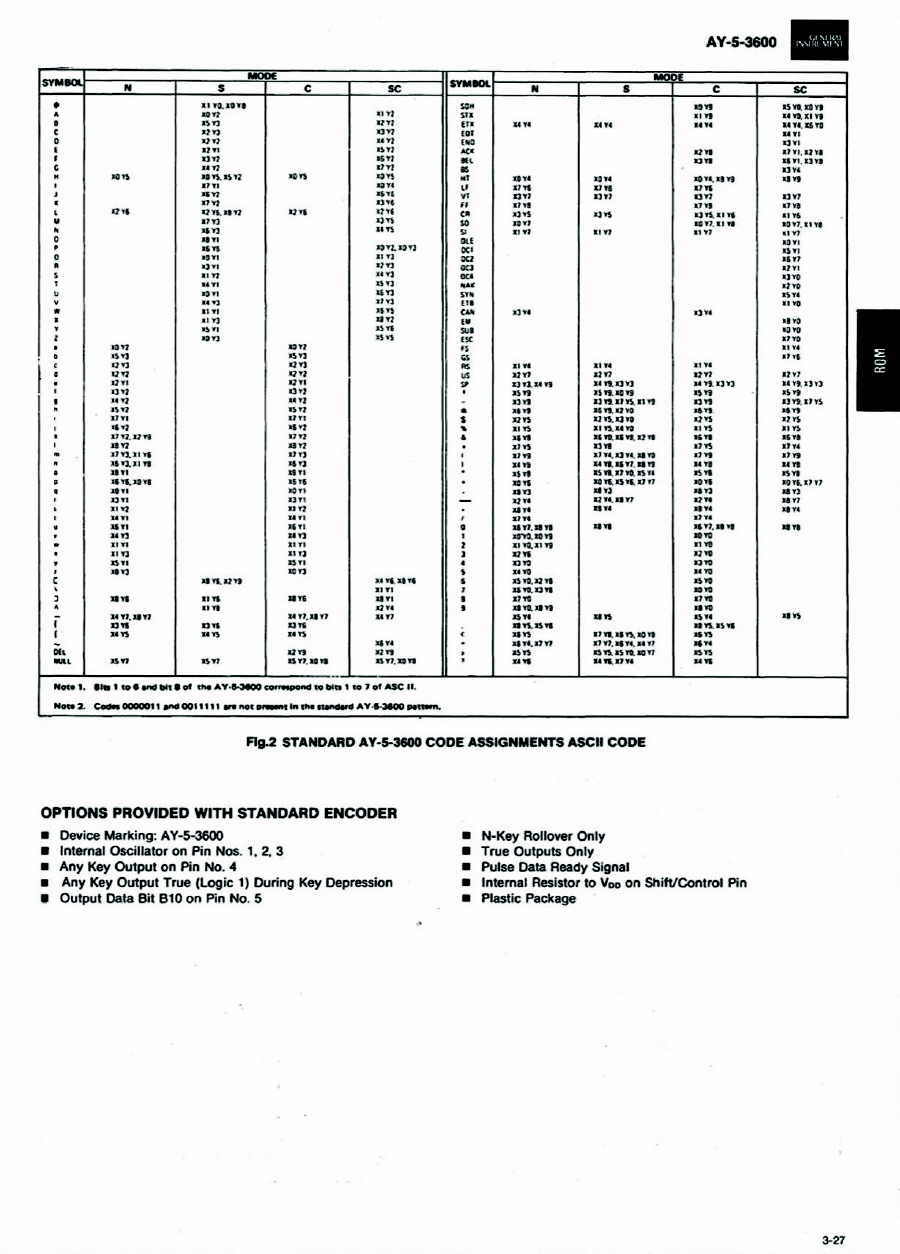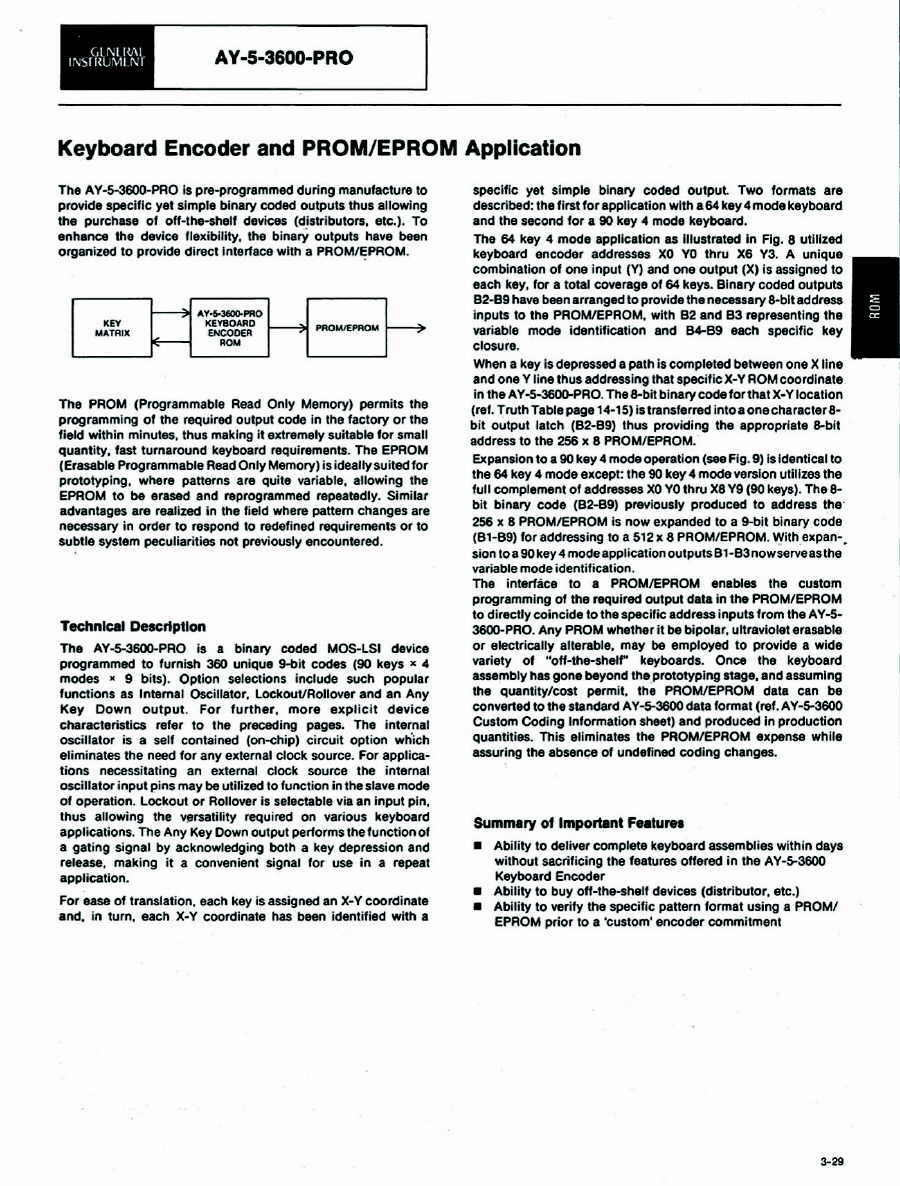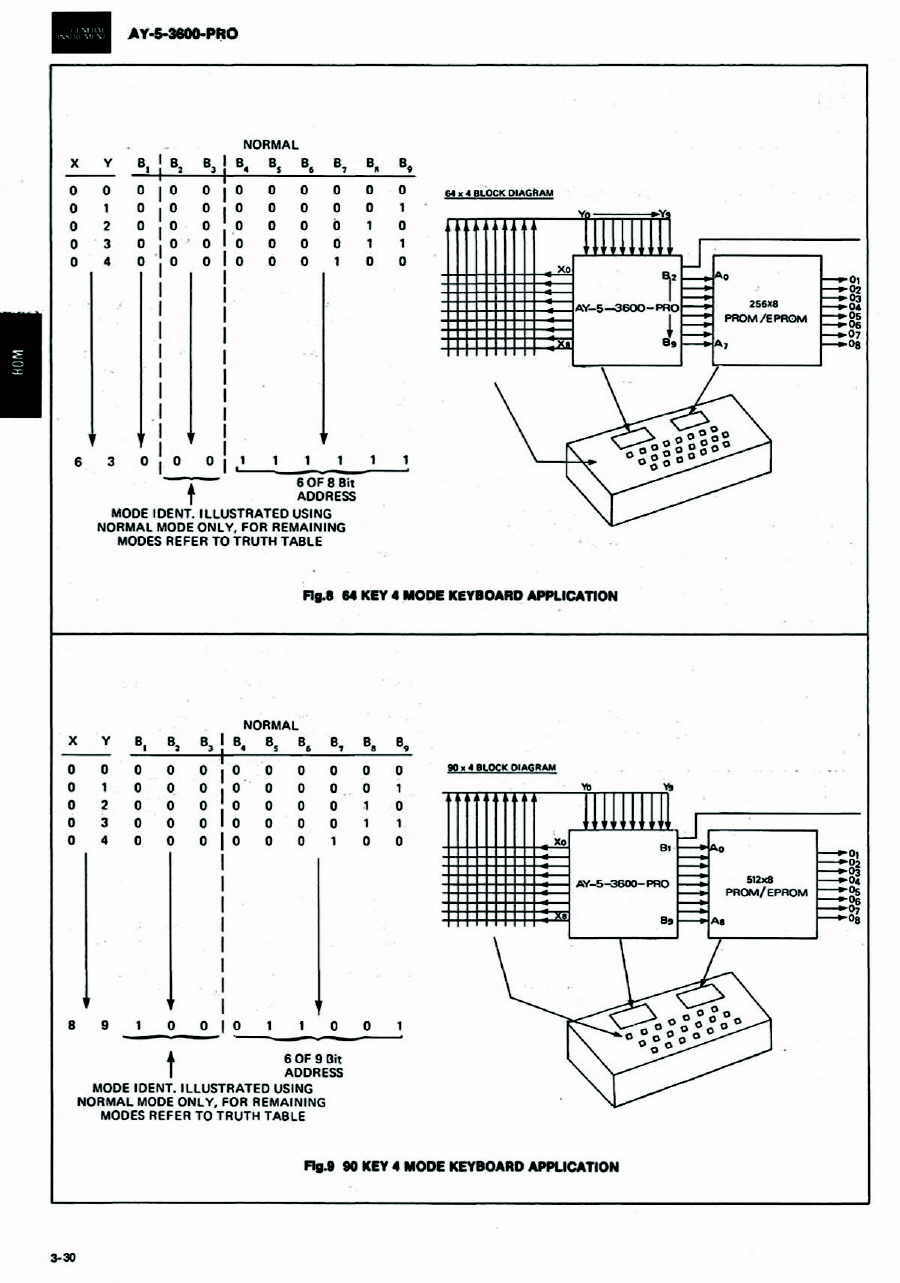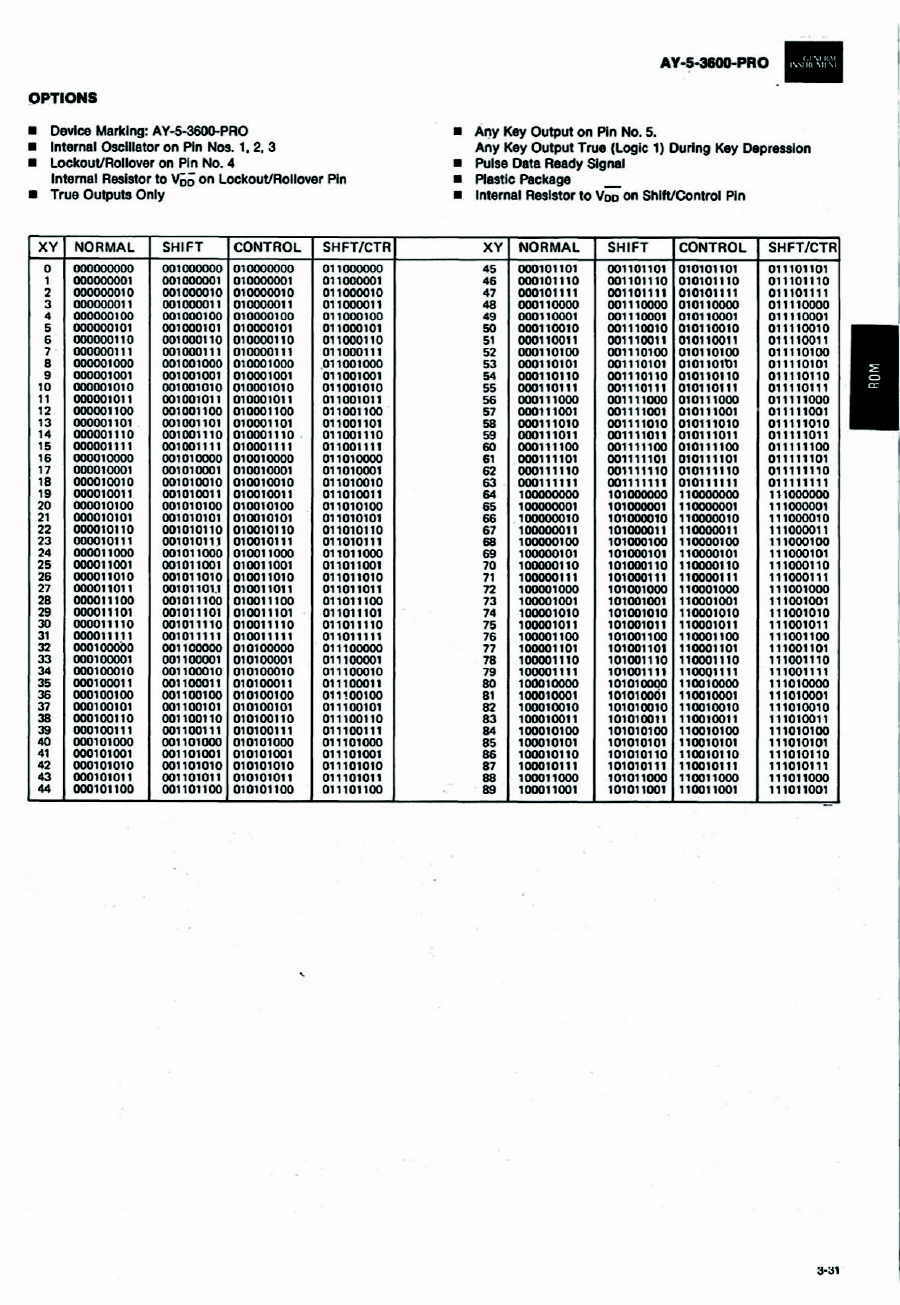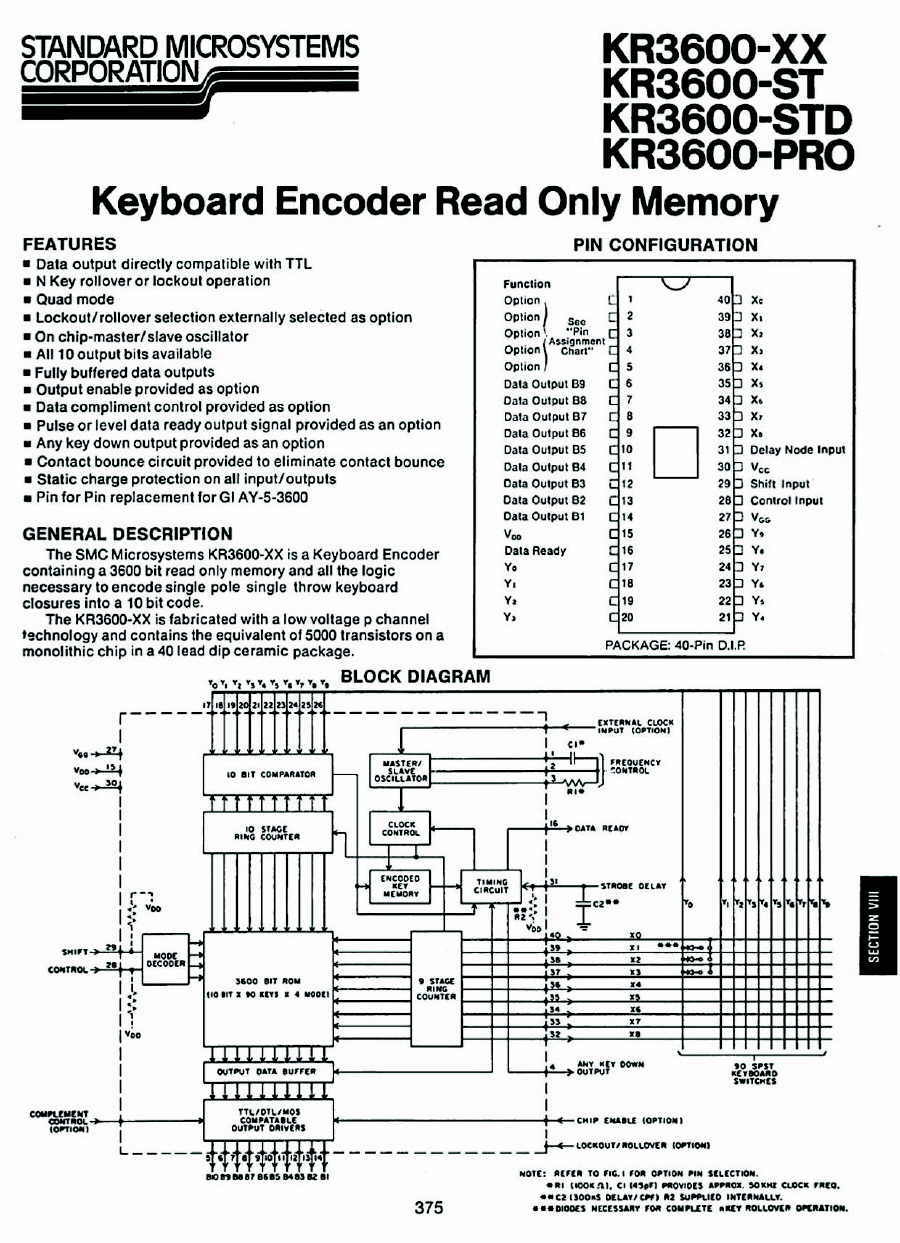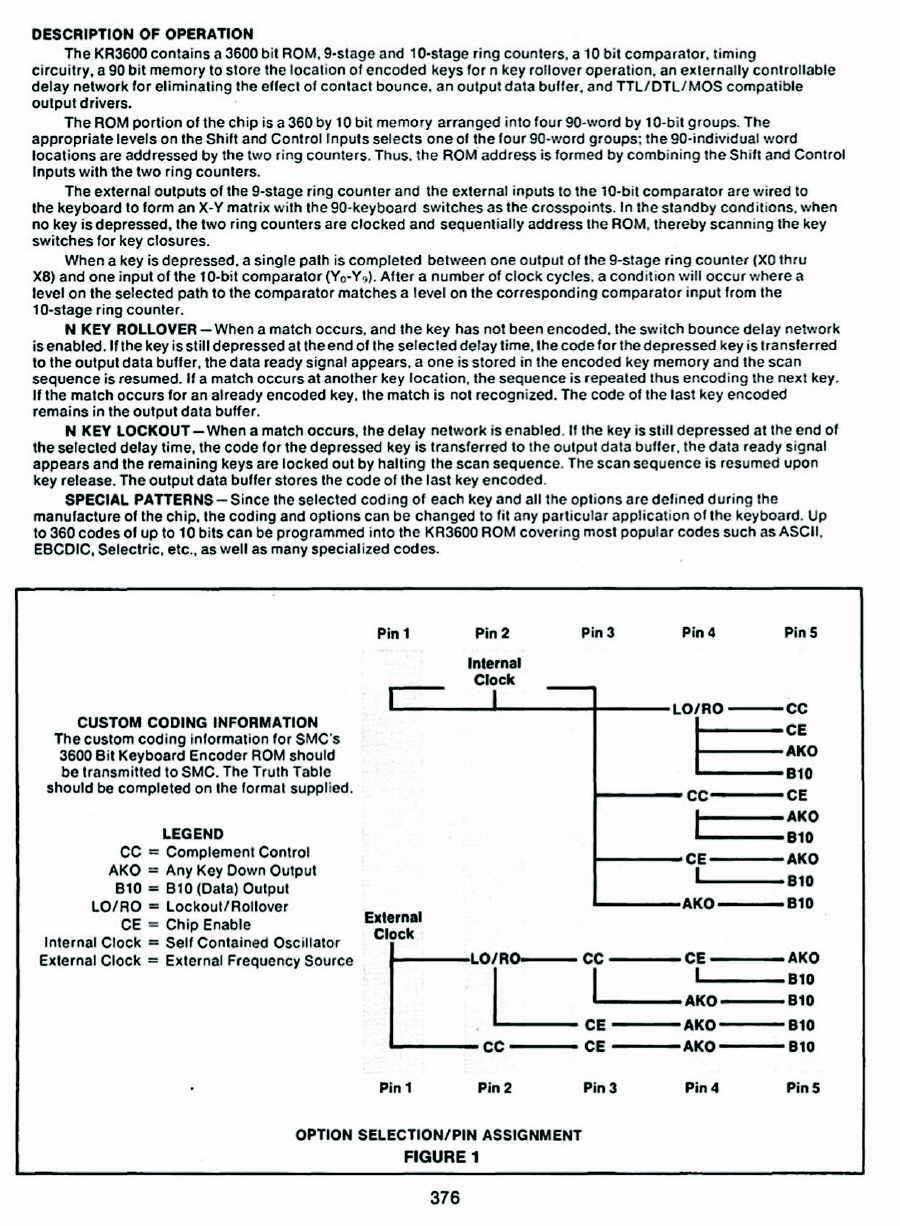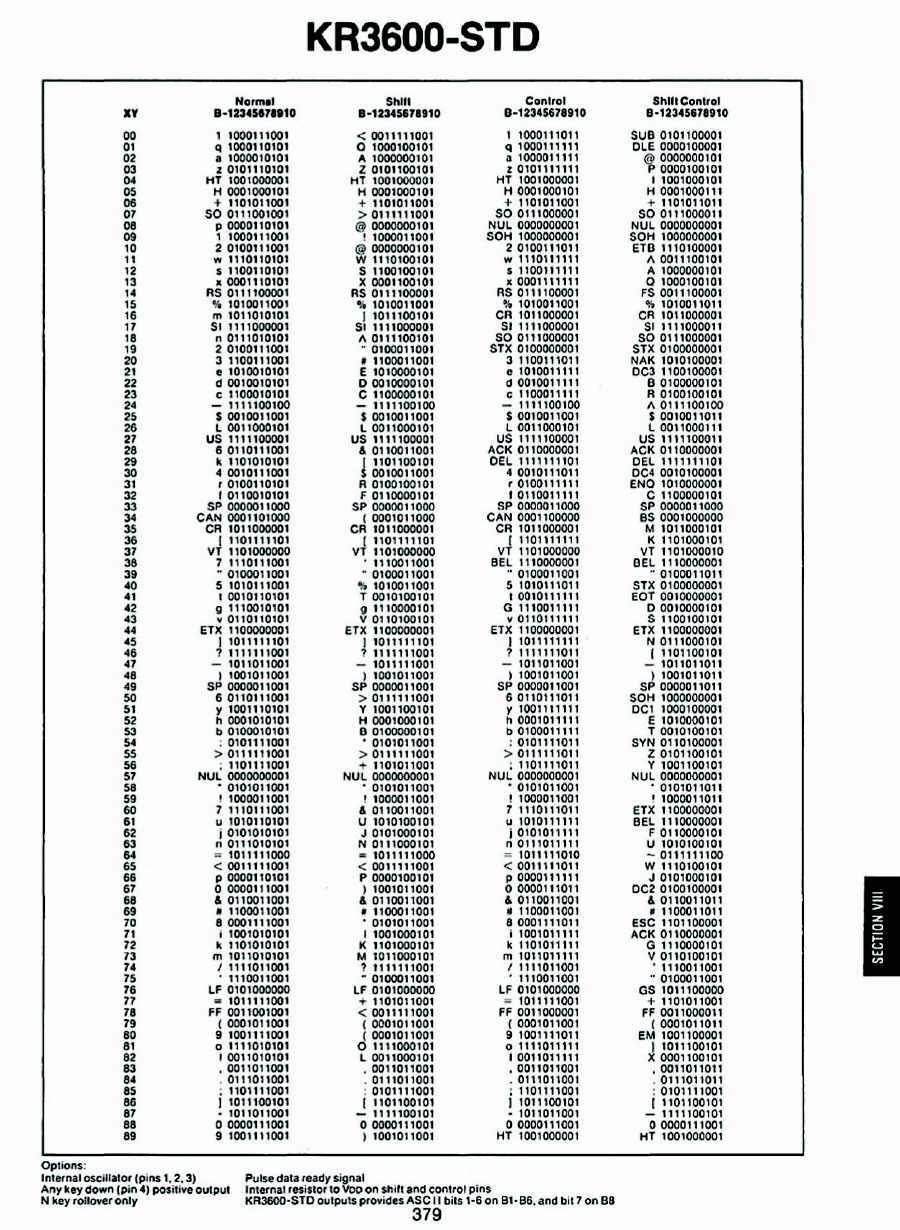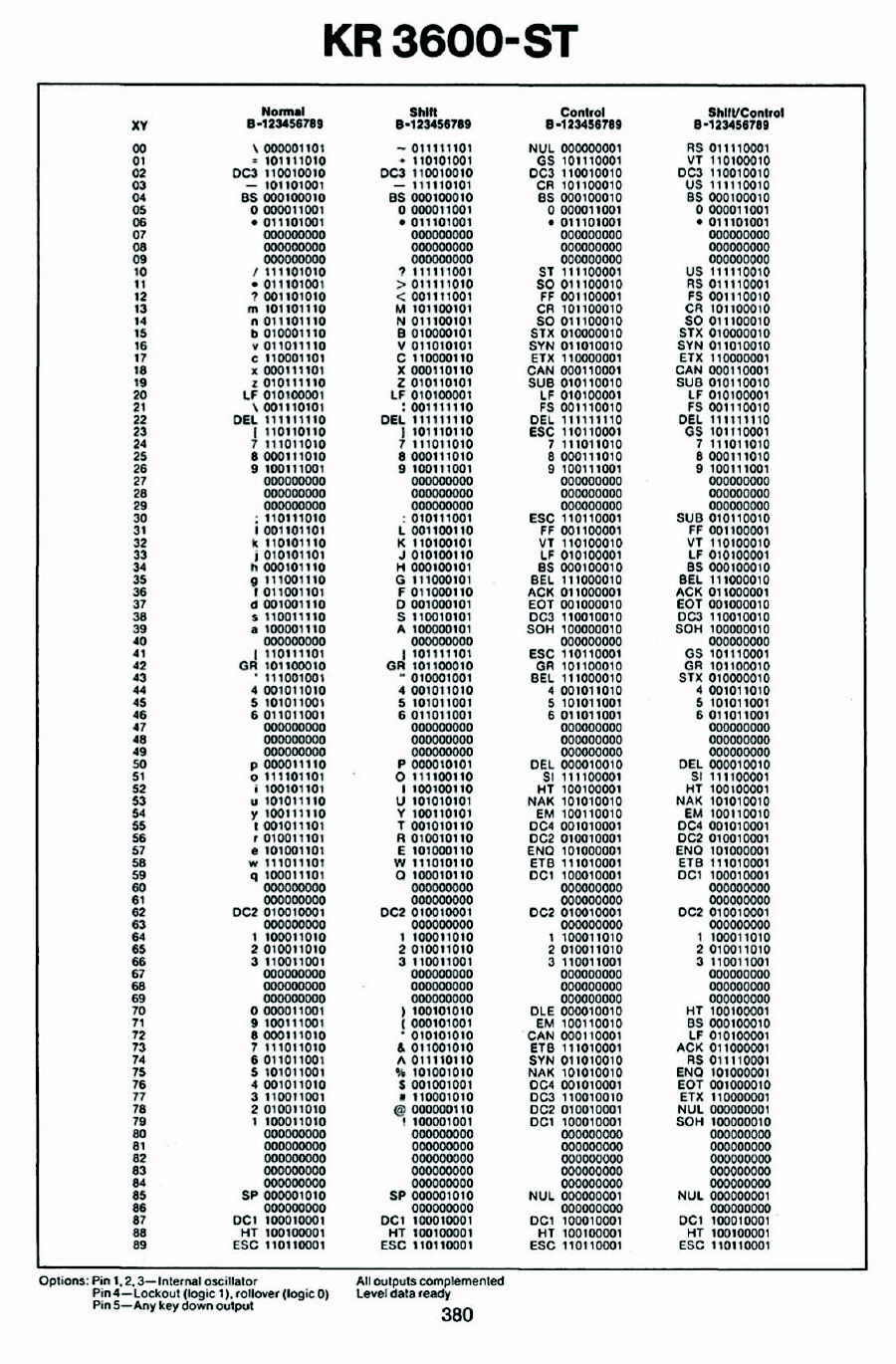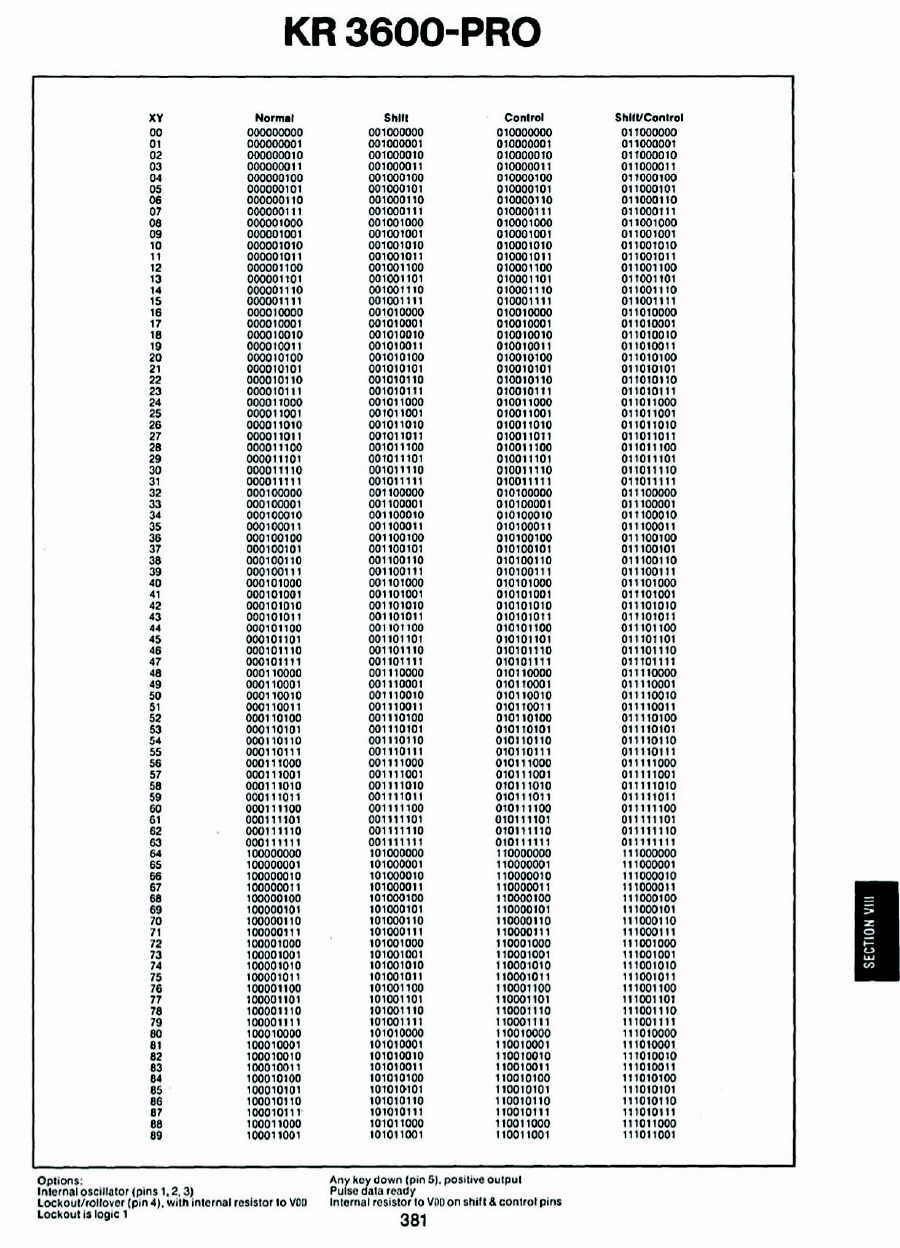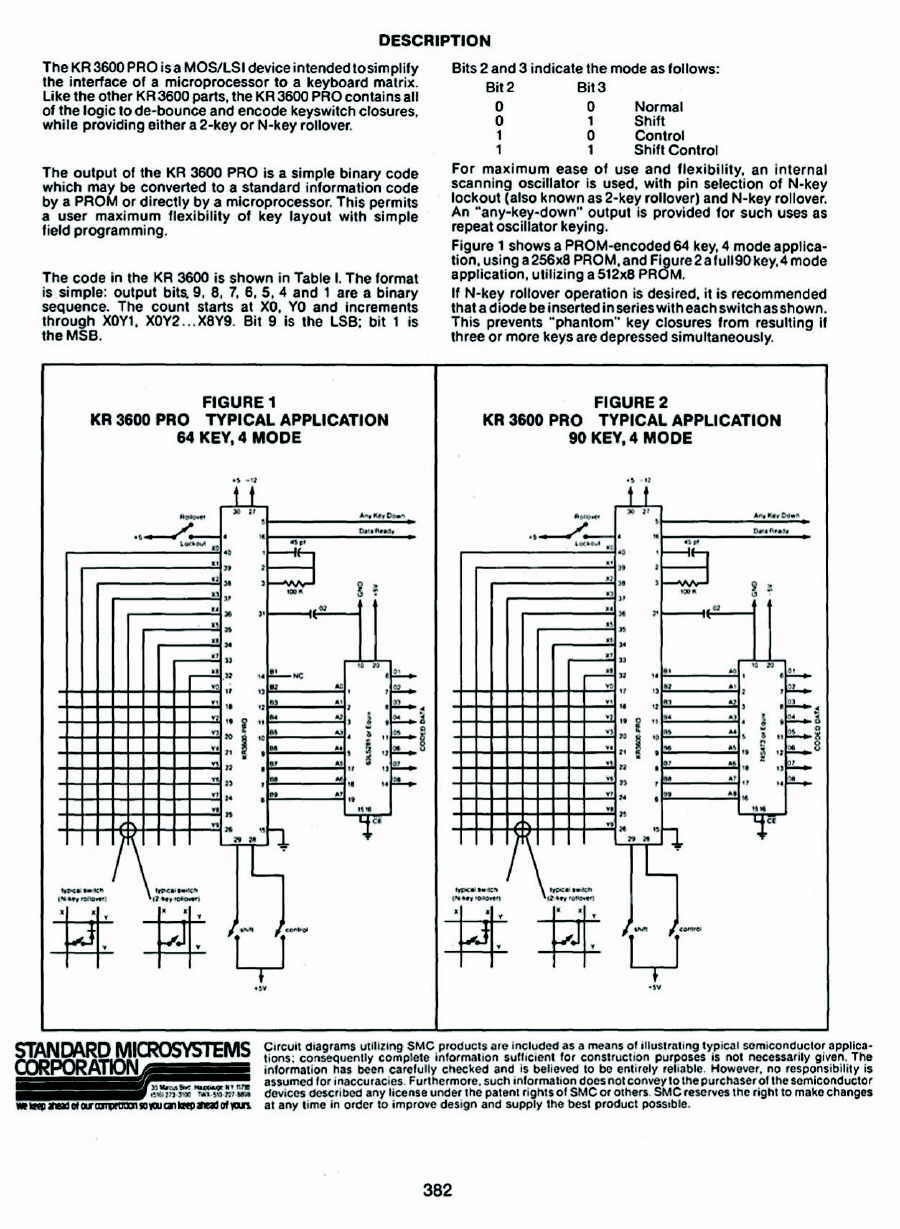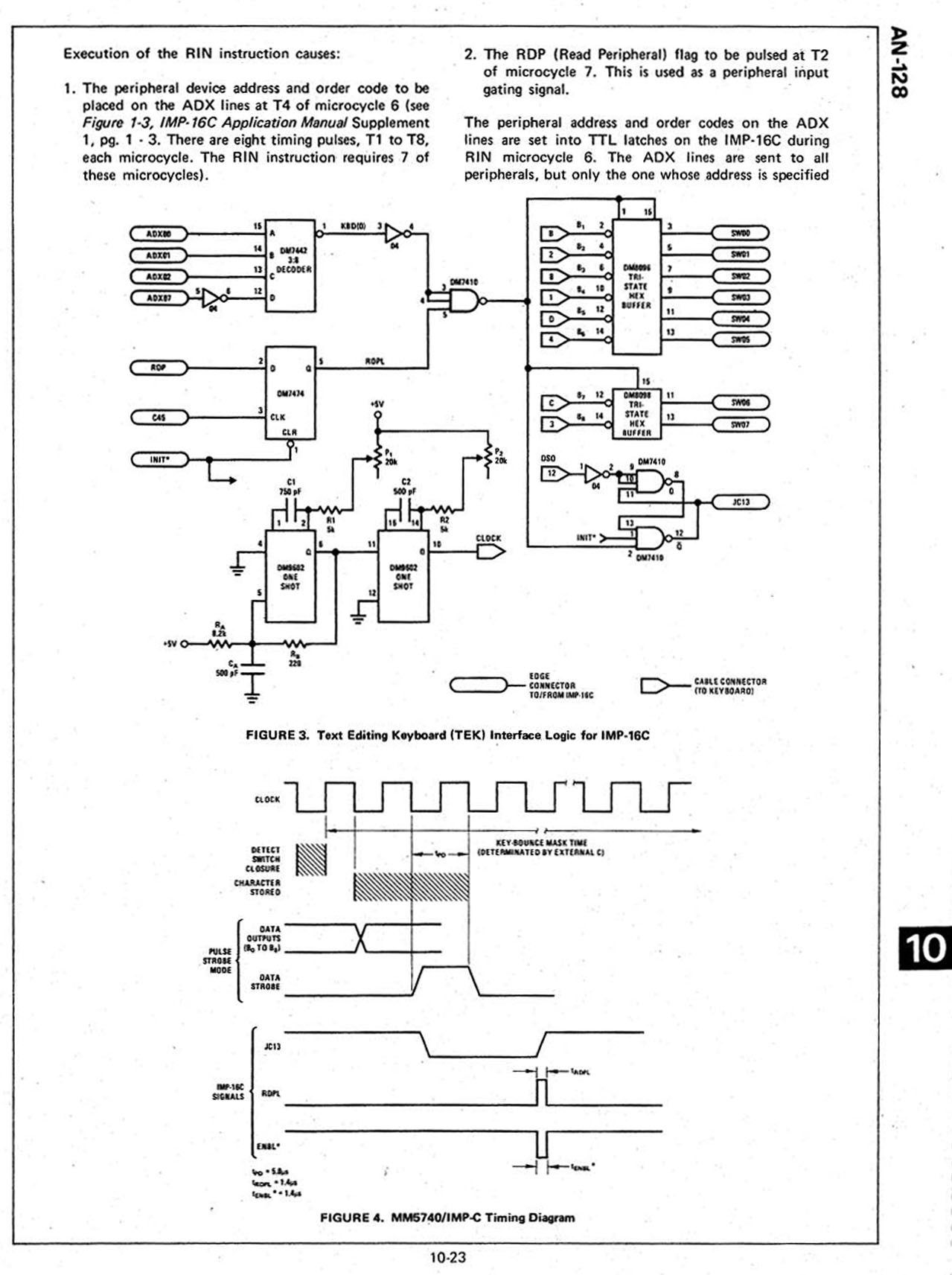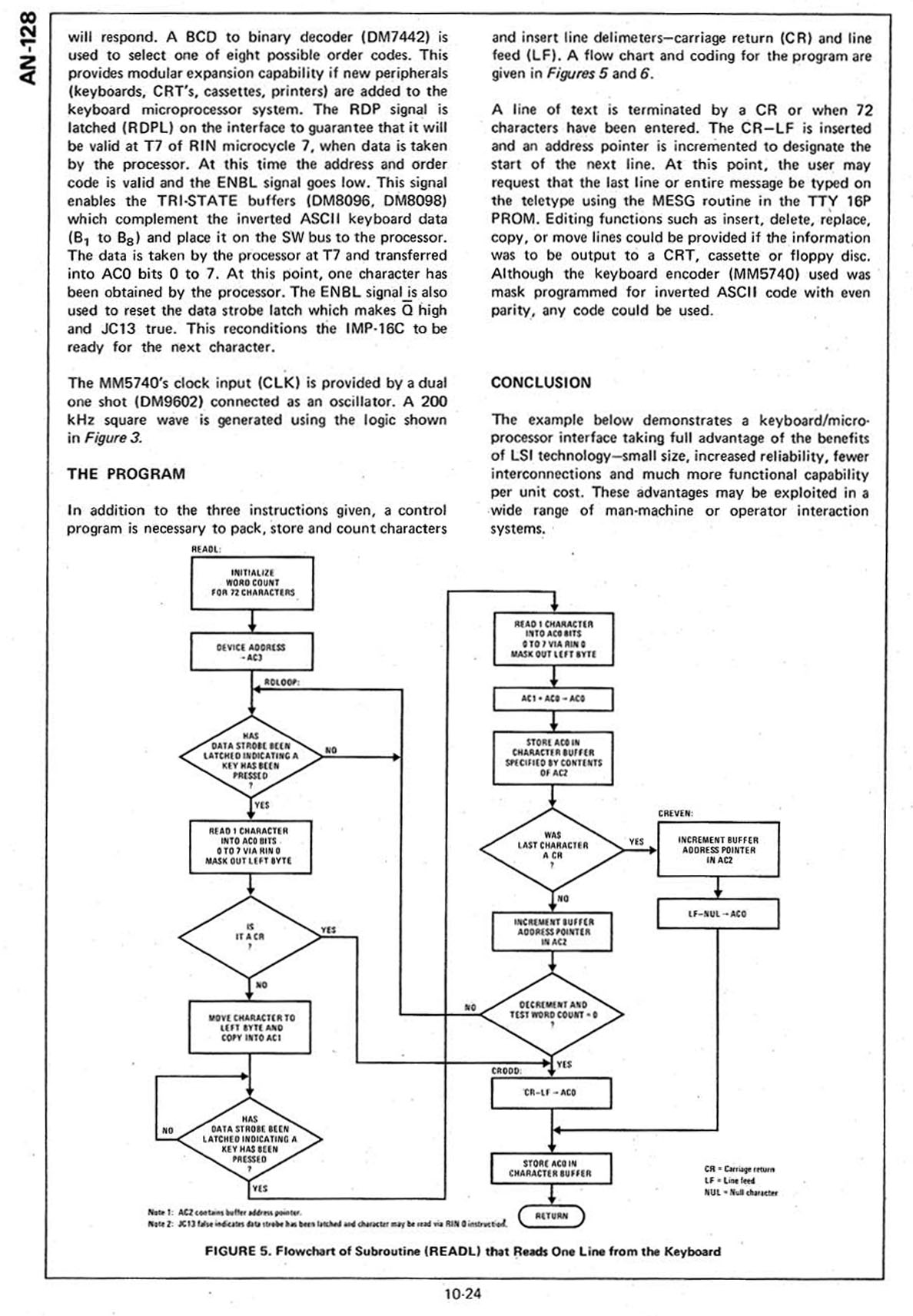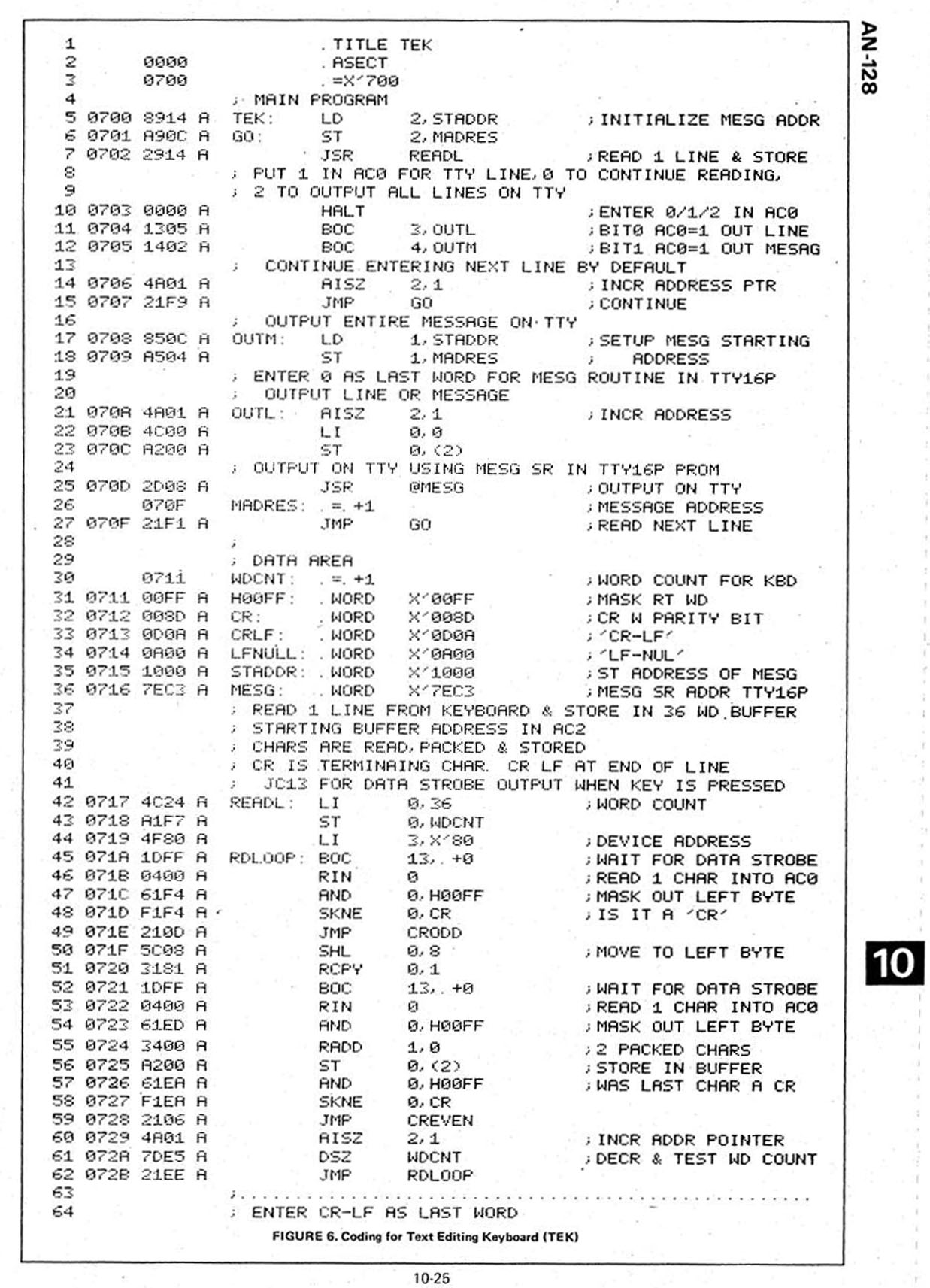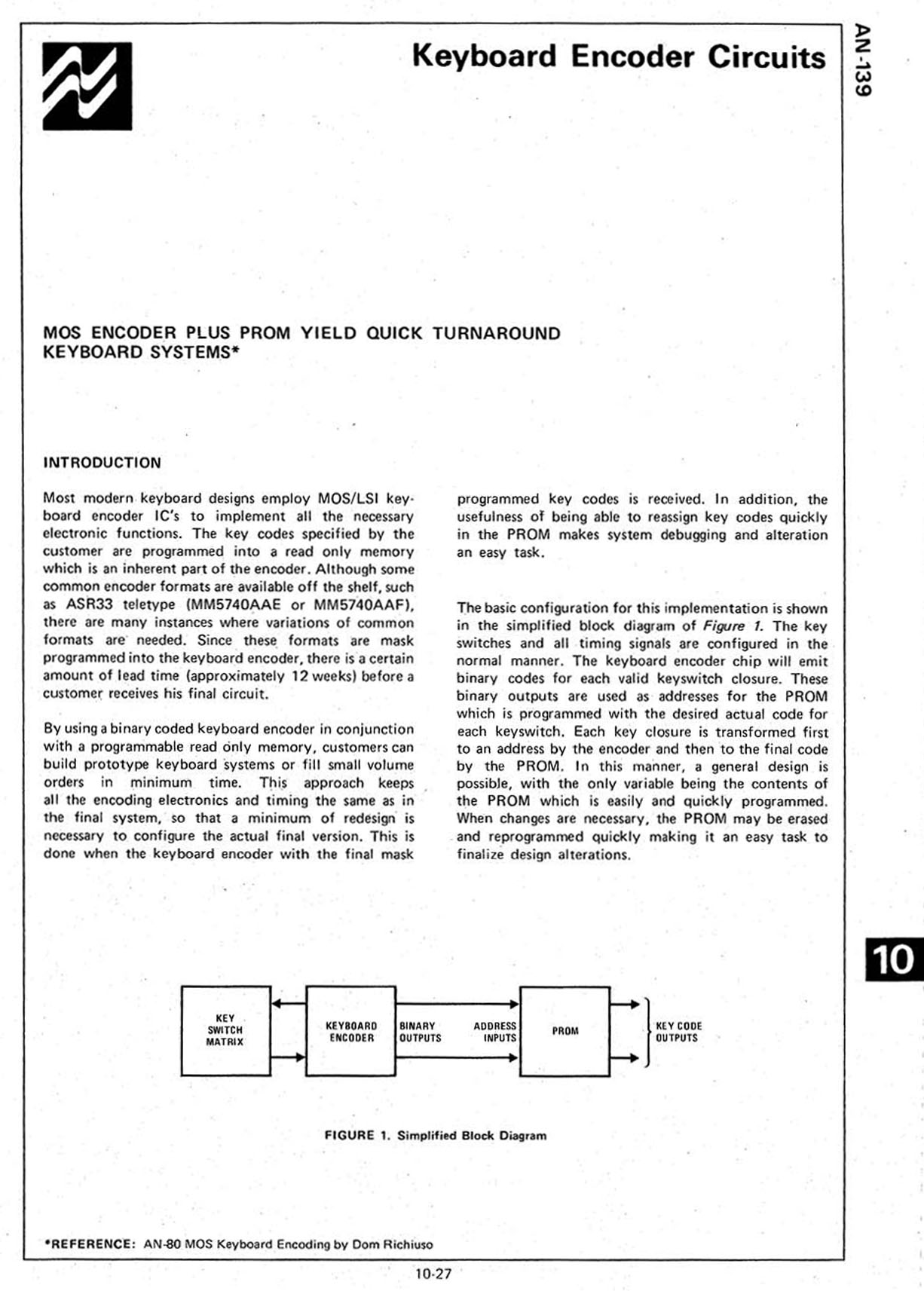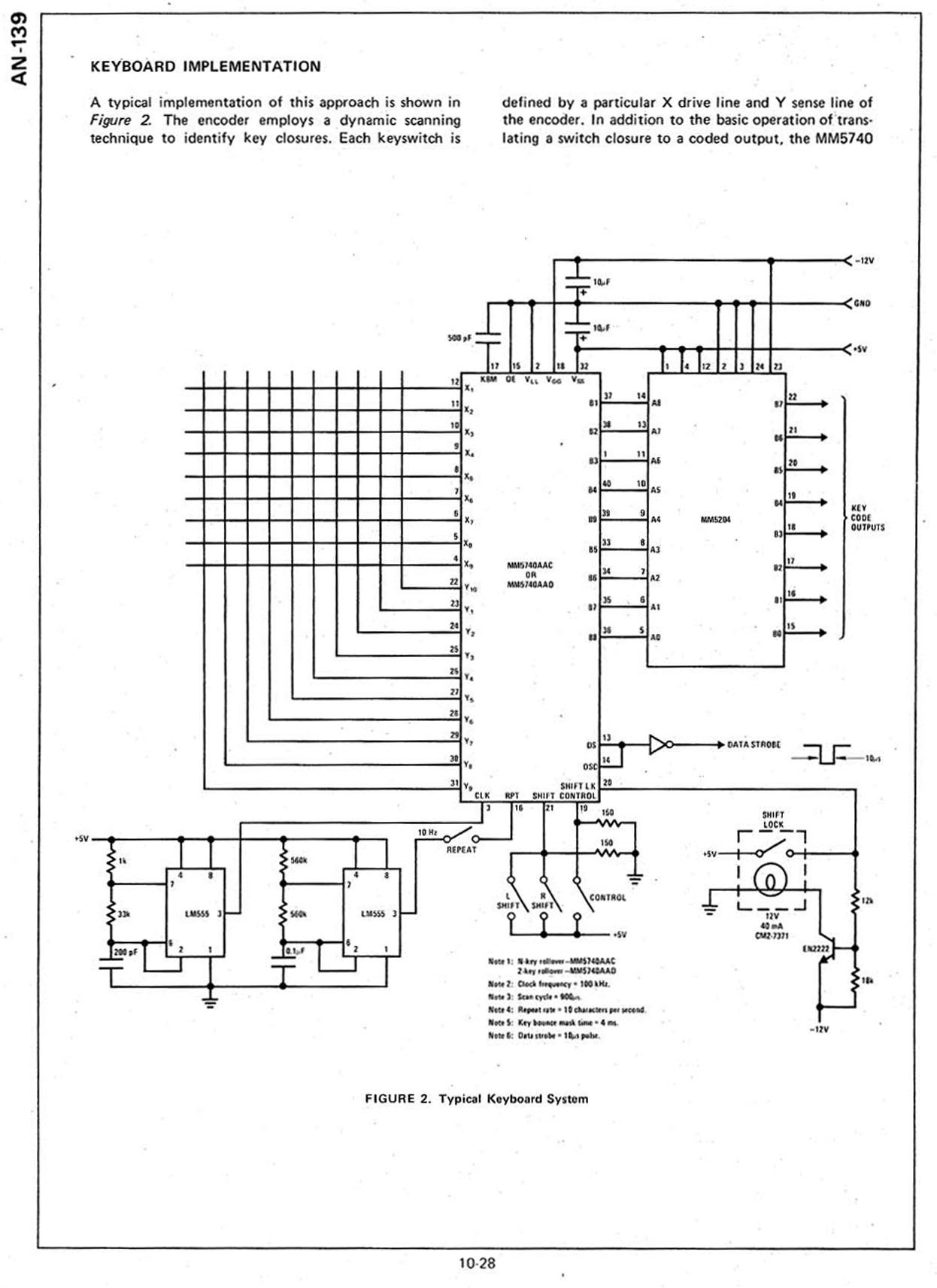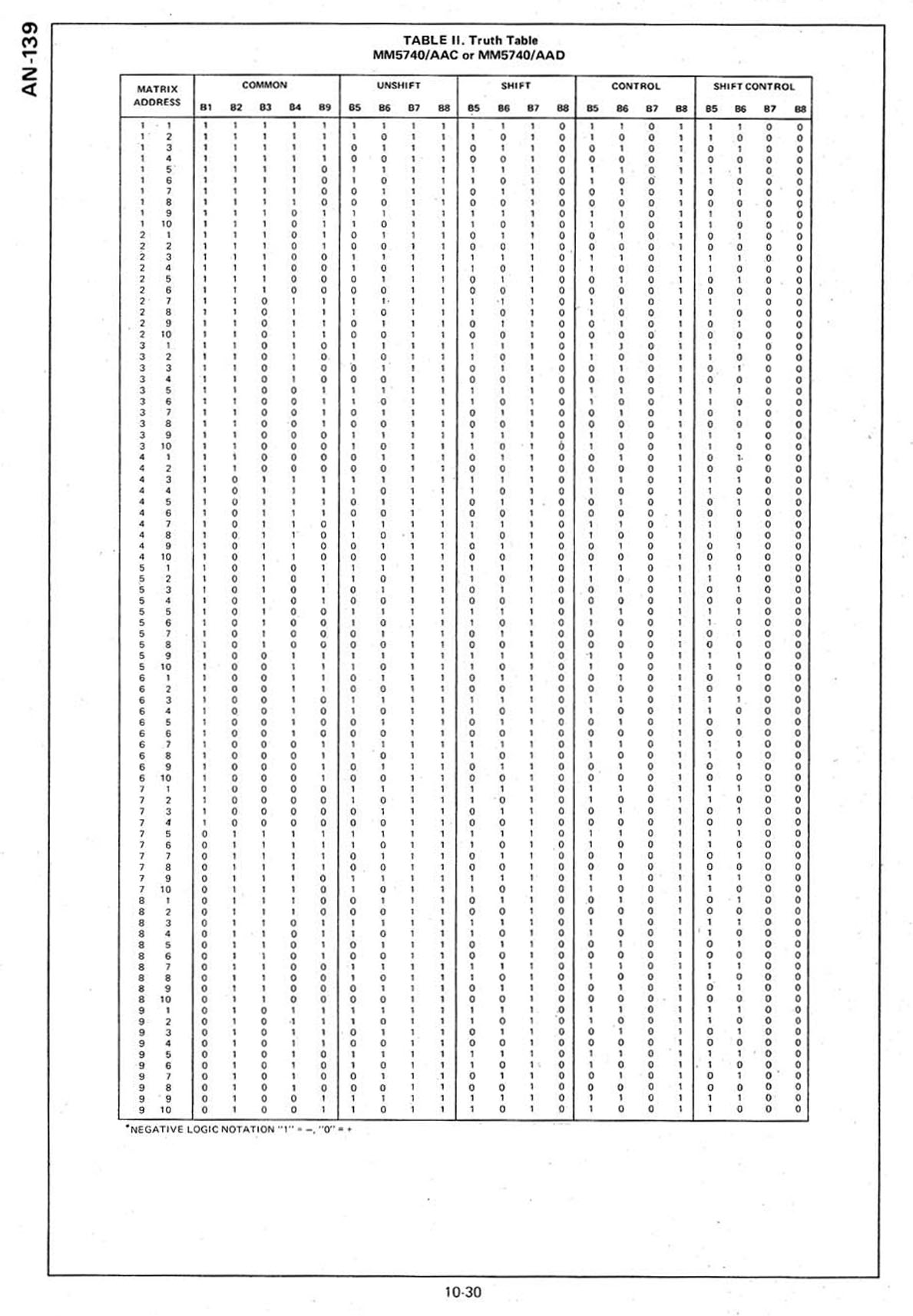Now lets take a look at Section D) 2 pictures before. It
displays 2 examples of a matrix...... the first splits the wires
in a matrix 4 x 4 and you might be able to mount 16
pushbuttons..... the other matrix is 5 x 3 and it provides us
only with the possibility to mount 15 pushbuttone and not
displayed in the picture but explained by simple arithmetics
would be a matrix of 2 x 6 and the matrix would only offer 12
points for mounting pushbuttons..... so with 8 wires
representing 8 Bits a matrix of 4 x 4 offers best
resolution..... probably you might waist some time
thinking about why this phenomenon happens ???
A hint: itīs got to do something with a greek man called
Pytagoras and a thing he discovered.....
But now back to the picture before and the
section E) ...... matrix-models used with decoderchips in
the 70īs to 80īs use 8 x 8 lines resulting in 64 possible
crossingpoints where a keybutton can be mounted...... and with a
special trick there can be up to 255 key-codes generated....
"Stop !" you might say loud ... "how can that be, that 64
buttons can resolve up to 255 items ( or how can you make 255
situations with only 64 buttons )? "
well lets examine the keys at the computer itself to discover
the trick..... the very first time the trick was performed was
when advancing from the Apple II to the II+ or II europlus. The
key we talk about was the shift-key ! All keys had before at the
older models only one code issued and one sign displayed and
that old models only had uppercase characters ! By adding the
shift-key the computer became the ability to do the same as the
most typewriting-machines by displaying upper case as well as
lowercase.....
so that one key doubled the amount of displayed and
representable keys and characters.... it was done by just adding
the amount of 64 bit to the true value of every key ! This was
done by the encoderchip that detected each keypress in the
matrix and treated some keys with very special "permissions"
to be pressed "together with another key"! The moment we
switched in the discusion from the basic 64 keys possible to be
decoded with diodes and wires to instead be decoded by a matrix
and a decoder chip is the very moment were we switched from
"hardware-coded-keyboards" to "software-coded-keyboards". This
happened in the years about 1979 to 1980 when a complete familly
of microprocessors were brought up to the market known as the
65XX-family and the 8051-family. These chips had some special
features in those days ( now thats nothing really upraising at
all ... ) but in those days it was amazing that these new chips
did not only contain a CPU but also some small amount of ROM and
RAM inside and a lot of lines outside as special
"communication"-lines.... this permitted the chip to
be progrqammed with a small program to act / react to incidents
happening at the communication-lines and the lines were
used to act as a matrix and the program permitted special
treatment / reaction to the hit of special selected
connections....
- and violá ! the encoder-chip was born....
the rest is rather simple ... after the schift.key was
"invented" soon at apple the "open-apple" and "closed apple" key
were invented at the apple computers while in the
Commodore-world and at IBM the Ctrl-key and Alt-key instead took
place. This enabled the programmers to make a giant leap in
programming special functions to ebable software to do a lot of
things with double keystroke instead of long lasting
commandchains... the trick by decoding was performed by adding
at the open-apple-key with another key the value of 128 was
added to the other key and with the closed apple-key the value
added was 192 !
you could call it a kind of "instant-driving a program with
special-key-commands" .... at the Apple the program Appleworks
was one of the very first programs with such enhancements ....
that was the birth of the so called "command-key-charts" often
printed on a carton and covered with plastic put on top of the
keyboard untill the user knew the commands by mind without the
charts....
the "losers" in those days were the
guys that just copied the disk and forgot to also xerox the
commandcharts because they never used the programs full features
and power.... and the biggest losers were those guys that
were to lazy to inspect the help-files on the disk too....
because in the most help-files there was also some documentation
on the "special-key-commands" .... so a lot of games never had
been played with joy but rather more stoking around the keyboard
to find out how to just even get the game running and how to
move around at all.....
if you ever get in such a situation the
firstaid is allways to hunt for documentation and for the
help-files ... it will save a lot of painfull struggles at the
keyboard....
but now back to the topic itself ....
another common thing in those days was the fact that a lot of
computers sold in foreign countries had been equipped with a
Char-ROM that contained a "national" ( say better foreign
"local" ) Character-set. This was a nice thing ... but there was
one big disadvantage :
A lot of companies were to lazy to translate their programs
developed for the U.S. Market to another language - so a very
large amount of programs requested to run with U.S.
Character-set..... so one of the most common modifications at
the Apple computers was replacing the Character ROM with a
larger Chip and a wire leading to a switch to permit switching
between the two Character-sets : the local one and the U.S.
version...... nearly the half of all Applecomputers ( including
the original ones and the clones ) had such a switch somewhere -
you would only have within the USA a chance to find computers
without such a switch.... Itīs a often performed
mistake to think this to be a task related to the decoder chip
.... Itīs NOT ! This is only related to the Character ROM !
But back to the encoderchips: with
upgrowing needs ( in other words: with growing amount of sold
computers ) the chip-companies like AMI, Intel National
semiconductor and others started to make own special
decoderchips and "public" decoderchips......
So whats the difference ? The public
decoder-chips could be bought by any customer at any
electronic-shop or it could be at least ordered from the catalog
and these chips had a documentation within the catalogs of the
chip-suppliers and a related "datasheet" that uncovered the
decoding itself by long lists of bytes being emitted when
striking a defined key ... the so called "truth-tables".... this
kind of decoders where used also by companies that built
different keyboards for different computers and different
computer models......
The opposite to this were the so calles
"custom-chips" - this special decoders were made on the demand
of companies making a large amount of same keyboards.... the
went up to the chip-company and asked them to make a series of
some say 10.000 chips with a decoder program only known by the
company itself and the code and the documantation was given back
to the keyboard-making-company and these chips were never sold
in public or documented in public.... this is true for
quite a lot of keyboards from cherry and a lot of keyboards made
in Taiwan in the late ī78 to ī85 made for clones....
most of this kind of chips have stange marks like TK-10 or
something like that and usually they donīt even have a real
company Logo.
But you should not condemn them all together.... some of these
keyboards were sold for a lot of bucks and the programmers in
those days loved some of them... just for example the so callesd
"Apple keyboard commander" : these keyboards had a special
feature - a "function"-key that permitted "rapid" programing ...
instead of typing the entire command "for " you just stroke once
while pressing the "function"-key the f-key and the entire
sequence of letters apeared at the prompt and the cursor was
positioned right one empty space after "for "... just waiting
for you to only enter the linenumber and then to continue
entering program-code... each letter when used with the
function-key was representing an entire command.... and that
saved a lot of typing at the times of the Apple II+ ! Several
keyboards from clones had that feature too...... in
most cases you could identify these kind of keyboards by the
fact that the caps on the keys also had on the front side
written very small the commands related to the very key.....
The next point with this topic of decoder chips is the
following: at hardwired keyboards the so called "debouncing" of
the keys was realized by wired logic omn the board that was
related to the so called flip-flop-chips and the
"bus-transcievers"/"latches" ... every mechanical key
produces while being pressed a series of so called
"micro"-contact-hits and that generates a number of keystrokes
issued within parts of a second.....
But of course the user only normaly wants to get one "a"-letter
when striking the key and not a series of 6 to 8 "a"īs ! So
every keyboard circuitary contains some kind of timing circuit
to eliminate the additional amount of letters. When the
decoder-chips came into the market this kind of timing was
integrated into the decoder chips -usualy realized with a so
called R-C combination with a capacitor and one resistor that
together set the time of delay before a new keystroke will be
accepted by the chip...... the resisitor loads up the capasitor
and when the capacitor was loaded to a defined limit the circuit
opens the gate for new entered strikes.... this is for
example a common problem with old keyboards.... if the
ceramic-capacitor at the decoderchip is damaged this causes a
series of letters issued to the computer if one single stroke
was issued..... at the IIe its the one with the marking C70 and
the resistor R32 close to the notched side of the decoderchip KR
3600-pro at the right front ( towards the keyboard ) of the
mainboard.
And finally we can now finish the roundup by talking about the
communication between the decoder chip and the computer
itself......
there must be some communication between both .... the chip must
give a signal to the computer that a kaystroke happened and the
computer must give some kind of notice to the chip after it
picked up the byte from the chip and tell the chip that the task
has been performed.......
so in normal case there is a signal line like "Strobe" that
indicates the keystroke and the line to instruct the chip that
the computer picked up the information like "control". The
correct used terms change from company to company so using the
correct term usually affords to read the datasheet of the chip.
Now following will be the datasheets of
the most common decoderchips and at the beginning sometimes some
short remarks by me.Thereafter is every time a link to permit
downloading the datasheet.
|
